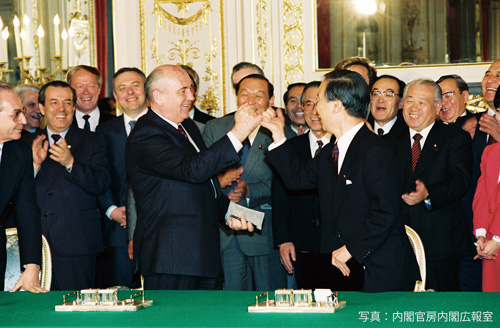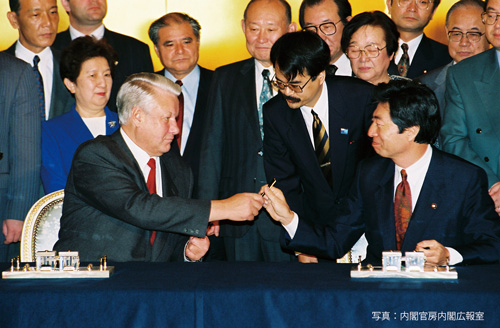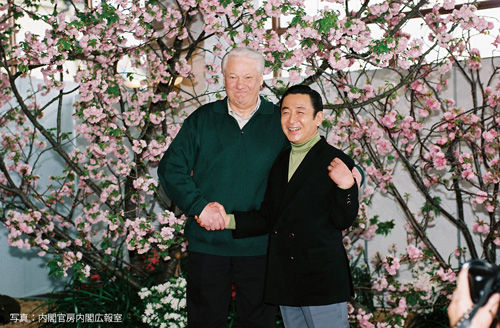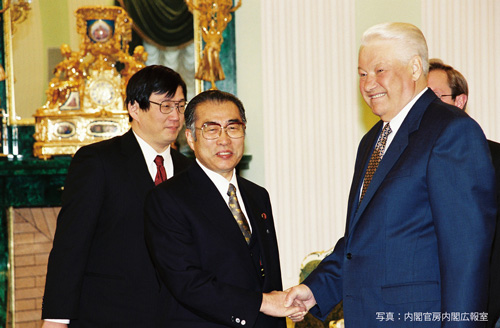1956–1998
October 1956
Joint Declaration by Japan and the Union of Soviet Socialist Republics (The Japan-Soviet Joint Declaration)
Japan and the Soviet Union agree to continue negotiations for the conclusion of a peace treaty and to hand over to Japan the Habomai Islands and the Island of Shikotan after its conclusion.
After the end of World War II, negotiations were held to conclude a peace treaty between Japan and the Soviet Union. However, in regard to the Four Northern Islands, an inherent territory of Japan, no agreement was reached regarding the issue of the attribution of Etorofu Island and Kunashiri Island. Then Japan and the Soviet Union concluded the Japan-Soviet Joint Declaration and thereby restored diplomatic relations. In Article 9 of the Declaration, it is clearly stated that the two countries “agreed to continue negotiations for the conclusion of a peace treaty.” The Soviet Union agreed to hand over to Japan the Habomai Islands and the Island of Shikotan. The actual handing over of these islands to Japan was to take place after the conclusion of a peace treaty.
Joint Declaration by Japan and the Union of Soviet Socialist Republics (Excerpt)
From 13 to 19 October 1956 negotiations were held at Moscow between the Delegations of Japan and the Union of Soviet Socialist Republics.
The following representatives of Japan took part in the negotiations:
Prime Minister, Ichiro Hatoyama,
Ichiro Kono, Minister of Agriculture and Forestry, and
Shunichi Matsumoto, Member of the House of Representatives.
The following representatives of the Union of Soviet Socialist Republics took part in the negotiations:
N. A. Bulganin, Chairman of the Council of Ministers of the USSR,
N. S. Khrushchev, Member of the Presidium of the Supreme Soviet of the USSR,
A. I. Mikoyan, First Vice-Chairman of the Council of Ministers of the USSR,
A. A. Gromyko, First Deputy Minister of Foreign Affairs of the USSR, and
N. T. Fedorenko, Deputy Minister of Foreign Affairs of the USSR.
In the course of the negotiations, which were held in an atmosphere of mutual understanding and co-operation, a full and frank exchange of views concerning relations between Japan and the Union of Soviet Socialist Republics took place. Japan and the Union of Soviet Socialist Republics fully agreed that the restoration of diplomatic relations between them would contribute to the development of mutual understanding and co-operation between the two States in the interests of peace and security in the Far East.
As a result of these negotiations between the Delegations of Japan and the Union of Soviet Socialist Republics, agreement was reached on the following:
1.The state of war between Japan and the Union of Soviet Socialist Republics shall cease on the date on which this Declaration enters into force and peace, friendship and good-neighbourly relations between them shall be restored.
9.Japan and the Union of Soviet Socialist Republics agree to continue, after the restoration of normal diplomatic relations between Japan and the Union of Soviet Socialist Republics, negotiations for the conclusion of a peace treaty.
The Union of Soviet Socialist Republics, desiring to meet the wishes of Japan and taking into consideration the interests of Japan, agrees to hand over to Japan the Habomai Islands and the island of Shikotan. However, the actual handing over of these islands to Japan shall take place after the conclusion of a peace treaty between Japan and the Union of Soviet Socialist Republics.
*Provisional translation

Prime Minister Kaifu and President Gorbachev, the signatories of the Joint Communique
(photo: Cabinet Public Relations Office, Cabinet Secretariat)
April 1991
President Gorbachev’s Visit to Japan
It is confirmed in writing that the four islands of the Habomai, Shikotan, Kunashiri, and Etorofu are the subject of the territorial issue.
President Gorbachev was the first Soviet leader to visit Japan. After a total of six rounds of in-depth negotiations with Prime Minister Toshiki Kaifu of Japan, a Japanese-Soviet Joint Communique was signed. This Joint Communique confirmed that negotiations on a peace treaty between the two countries, “including the issue of territorial demarcation, taking into consideration the positions of each side on the attribution of the islands of Habomai, Shikotan, Kunashiri, and Etorofu” had been held, and that “the peace treaty should be the document finally concluding the post-war settlement including the resolution of the territorial issue.” It was made clear for the first time in writing that the four islands of Habomai, Shikotan, Kunashiri, and Etorofu were the subject of the territorial issue that should be solved by a peace treaty.

Prime Minister Morihiro Hosokawa signs the “Tokyo Declaration” with President Yeltsin
(photo: Cabinet Public Relations Office, Cabinet Secretariat)
October 1993
President Yeltsin’s Visit to Japan
The Tokyo Declaration on Japan-Russia Relations is signed, confirming the continuation of negotiations towards an early conclusion of a peace treaty.
As a result of the summit meeting between Prime Minister Morihiro Hosokawa and President Yeltsin, the “Tokyo Declaration on Japan-Russia Relations” was signed, which declared that both leaders had undertaken serious negotiations on the issue of attribution of the islands of Etorofu, Kunashiri, Shikotan and Habomai, and that both sides agreed to continue negotiations towards an early conclusion of a peace treaty through the resolution of this issue based on the historical and legal facts, the documents to which both parties had agreed as well as the principles of law and justice, and to thereby fully normalize the bilateral relations.

Prime Minister Hashimoto in the meeting with President Yeltsin
(photo: Cabinet Public Relations Office, Cabinet Secretariat)
April 1998
The Summit Meeting in Kawana
Prime Minister Hashimoto makes a proposal for the resolution of the territorial issue.
In Kawana in Shizuoka Prefecture during his visit to Japan, President Yeltsin and Prime Minister Ryutaro Hashimoto held a summit meeting. In this meeting, the relation between Japan and Russia, , having made steady progress since the Krasnoyarsk Summit Meeting held in Russia the previous year expanded even further across all fields. In particular, both leaders agreed that by a peace treaty the issue of attribution of the four islands should be resolved on the basis of paragraph 2 of the Tokyo Declaration, and also such principles as friendship and cooperation between Japan and Russia should be incorporated therein as we move into the 21st century.” Furthermore, Prime Minister Hashimoto made a proposal (Kawana Proposal) for the resolution of the territorial issue.

Prime Minister Obuchi in the meeting with President Yeltsin in Moscow
(photo: Cabinet Public Relations Office, Cabinet Secretariat)
November 1998
The Summit Meeting in Moscow
The Moscow Declaration on Establishing a Creative Partnership is signed.
Prime Minister Keizo Obuchi made an official visit to Russia for the first time in 25 years as a Prime Minister of Japan. Both leaders signed the “Moscow Declaration on Establishing a Creative Partnership between Japan and the Russian Federation.” The two leaders instructed each government to accelerate negotiations on a peace treaty based on the Tokyo Declaration as well as on the agreements in Krasnoyarsk and Kawana. In regard to the issue of a peace treaty, Russia provided its response to the Kawana Proposal, and the Japanese side decided to take some time to consider.






